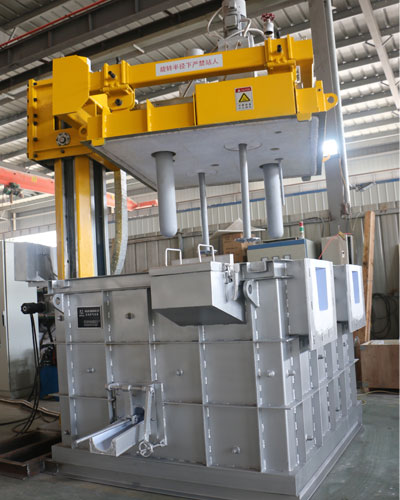In the process of casting and rolling of aluminum-magnesium-silicon high-strength aluminum alloy rods, the use of online refining equipment for degassing and foam ceramic filter plate filtration has become more and more widespread.
The aluminum melt online refining device was first invented by the United Carbide Corporation in 1974. Its working principle is to inject high-purity inert gas into the aluminum liquid through a high-speed rotating graphite rotor nozzle to form a large number of dispersed bubbles. The liquid is fully contacted, and the hydrogen in the aluminum melt is diffused into the bubbles, and the aluminum liquid is brought out as the bubbles rise to realize the degassing process. At the same time, when small bubbles are rising, due to the mechanism of tension adsorption, some small inclusions can be adsorbed to achieve slag removal.
The online refining device with graphite rotor rotating and spraying is used for degassing. The high-speed rotating graphite rotor is used to cut the inert gas injected into the aluminum liquid into very small bubbles, which greatly increases the contact area between the inert gas bubbles and the aluminum liquid, and improves The degassing efficiency, under the premise of using high-purity inert gas, can reduce the hydrogen content to less than 0.12 ml per 100 g of aluminum. It is currently a widely used online degassing device. On-line filtration of aluminum melt mainly includes: glass cloth filtration, foam ceramic plate filtration, tubular filtration and deep bed filtration.

Glass cloth filtering aluminum melt belongs to flat-screen coarse filtration, which mechanically separates coarse inclusions through the action of fences, but can not remove fine inclusions. It has been eliminated or only used as primary coarse filtration at the outlet of the furnace.
At present, the most commonly used and most effective method of filtering and removing impurities is to use foam ceramic filter plates. The aluminum liquid flows through the tortuous holes of the ceramic, and the inclusion particles contained in the ceramic plate are trapped in the ceramic plate under the three effects of blocking, deposition and adsorption. The inner surface of the hole and the crevice cave, so that the inclusion particles are separated from the aluminum liquid.
The ceramic foam filter plate is a standard product, with a thickness of 2 in (1in = 0. 0254 m), the same length and width dimensions, and a side inclination angle of 17. 5°. The diagonal length is usually used to define the specifications, and the porosity of the filter plate is expressed in PPI. The larger the PPI, the smaller the pores. The porosity of the filter plate determines the final filtration accuracy. The slower the flow rate of the aluminum liquid in the filter plate, the better the filtering effect.

